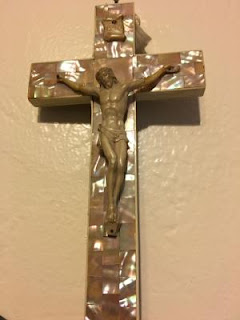Photo: Memorial Crucifix of Belgian black granite with bronze corpus (total weight three tons), presented to the Church of Saint Paul the Apostle on December 8, 1897 in honor of the Golden Jubilee of priestly ordination of Fr. Augustine Hewit (1820-1897), one of Fr. Hecker’s collaborators in the founding of the Paulist Fathers, and second Paulist Superior and Pastor (1889-1897).
Twenty-one years ago today, this church was filled to overflowing, following the terrorist attack which we had experienced in this city just three days before. That was the only one occasion when I have ever seen this great church so filled, filled to capacity, filled as it was designed to be. On that unforgettable September Friday, we were a community in mourning and a city still in shock. But, when we assembled that day for Mass, we did what the Church always does on September 14. We celebrated the Exaltation of the Holy Cross, the symbol of our salvation. As Servant of God Isaac Hecker expressed it, The only bridge to heaven is over the cross. The gates of paradise are only opened with the key of the cross.
Historically, this feast commemorates the dedication, on September 13, 335, of the Basilica of the Holy Sepulcher in Jerusalem – built by the Roman Emperor Constantine over the traditionally recognized sites of Christ’s crucifixion and of his burial and resurrection. The next day, the relic of the True Cross (which had been discovered by Constantine’s mother, the Empress Saint Helena in 320) was publicly venerated in the new basilica. Eventually, September 14 became the feast celebrated today throughout the Universal Church.
On one level, this feast is yet another celebration of Christianity’s triumph over Roman paganism. (The date for the dedication of the Jerusalem Basilica may have been chosen to counteract the anniversary of the dedication of the Temple of Jupiter in Rome – ironically now the site of united Italy’s 1911 monument to King Victor Emmanuel II, a monument to the triumph of modern secularism). Ultimately, however, what we celebrate today is Christ’s triumph over our sad human history of evil and sin – now transformed, once and for all, through the triumph of Christ’s cross.
Evil and sin do not happen simply by accident – and neither did the cross. It didn’t just happen to Jesus one day, like some inexplicable misfortune – like various sufferings and setbacks, which, when they happen in our own lives, we sometimes all too glibly refer to as “crosses.” Christ’s cross was a direct consequence of his confrontation with evil and sin in the world and became the means by which he overcame evil and sin.
In Jesus, the cross has become our doorway to salvation. A dreaded instrument of disgraceful death, the cross is now, thanks to Jesus, our gateway to freedom and new life, a triumphant sign of glory. And that is why we celebrate the Cross. As Saint Augustine said in a sermon somewhere around the year 400, You’re a Christian, you carry on your forehead the cross of Christ [Sermon 302, 3].
In the familiar story we just heard, [Numbers 21:4b-9], God punished his perpetually complaining people with serpents, which bit the people so that many of them died. But, when Moses interceded on the people’s behalf, he was instructed to make an image of a serpent, mounted on a pole, and whenever anyone who had been bitten by a serpent looked at it, he lived.
Like the people in the desert, we experience all sorts of sufferings and setbacks and are prone to discouragement and self-pity. But the mystery of the cross invites us to see our situation differently. It invites us to turn away from our obsessive, dead-end focus on ourselves, and to turn instead to Christ – to delight, as Saint Augustine said in that same sermon, not in the sign of the wood, but in the sign of the one hanging on it. The mystery of the cross invites us to turn away once and for all from our obsessive, dead-end focus on ourselves – and the seemingly endless sufferings and setbacks that continue to break our hearts – and to turn instead to Christ, so that we may journey through the desert of this treacherous life without fear, under the sign of the cross, which alone can conquer in our war-torn, terrorized, religiously and politically polarized world.
Homily for the feast of the Exaltation of the Holy Cross, Saint Paul the Apostle Church, NY, September 14, 2022.





